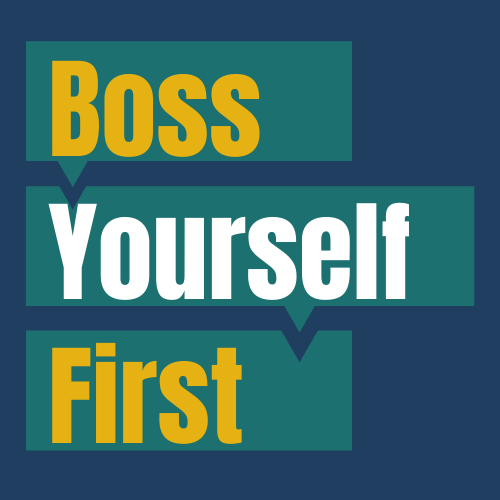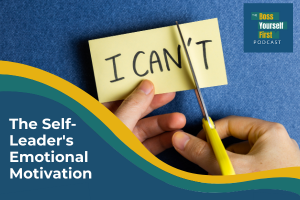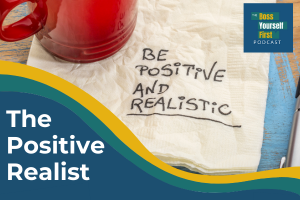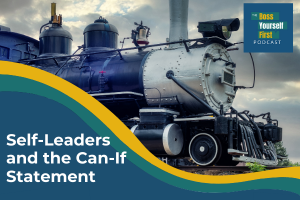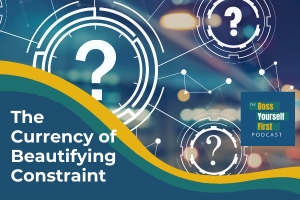The Self-Leader’s Emotional Motivation
On today’s episode, we’re learning how to link and leverage emotional motivation to the process of making constraints beautiful and get the results we want. This is a great framework for building powerful emotional narrative around your desired results. Remember to grab your infographic for this episode at bossyourselffirst.com on the resource page under this episode.
Episode Transcript
Boss Yourself First –
BYF Podcast Season 2 Episode 7
Hey everyone, welcome to the Boss Yourself First Podcast. We’ve spent this season exploring constraint. And I have to tell you, that it’s caused a little friction for me at home. My family and I were talking about ideas to grow the podcast and my daughter suggested that I might gain more listeners if I use the word Constraint less. You see the humans that I live with get to hear a lot about the podcast season before its even the podcast season, so while you’ve been hearing about constraint for 7 weeks now, they’ve been living with it for months. Also, you have a choice and can just stop the podcast. My family is a bit of a captive audience – they’ve even suggested that instead of a swear jar, I need to put money in for using the word constraint. But we here on the podcast are going to power through and continue exploring how to leverage constraint to slingshot forward toward our desired results. Last week we learned about mental contrasting and the WOOP method so if you missed that, have a listen to episode 6 of season two. And that really lays the foundation for today’s discussion about tapping into strong emotions for motivation to successfully process constraints. As Morgan and Barden say in their book “A Beautiful Constraint”, “To make constraints beautiful, we need to identify the activating emotions able to fuel more creative tenacity.” And to really create strong emotional connection we’ll utilize the mental contrasting we discussed last week to leverage the tension and energy of both negative and positive emotions.
To mine for the most powerful emotions and to connect them with the propelling question Barden and Morgan say we need to create emotional narrative. And I want to remind you that a propelling question is a question that combines a bold ambition with significant constraint. Like how do I make enough with my restaurant to keep all of my employees during a pandemic where I can’t have inside dining? If you want more of a refresh on propelling questions check out season 2 episode 3 .
So emotional narrative is basically a story that highlights powerful emotional attachments with achieving our desired results and failing to achieve them.
This is going to take some reflection and for some of us, we just want to get the solution and move on. But remember that in the process of leveraging constraint to move forward, dealing with one constraint often reveals another and another after that. Tapping into emotions for motivation will help us be in the process for the long haul. It’s worth taking a little reflection time on the front end to have enough motivation to get all the way through to the desired result. Morgan and Barden have an approach to help us get the material for our emotional narrative. First, when you think of your propelling question, why is it important to you?
Second, they recommend checking in with 8 basic emotions to reveal connections with your propelling question. As I said, we’re looking for connections not trying to create or muster up emotions. We’re all human, and we already have emotions, we’re just searching for the strongest activating emotions. So they suggest working through the list of 8 emotions fear, excitement, love, desire, pride, greed, hate and rage asking yourself for the connection. For example, what scares you about this challenge? What are you afraid of in this challenge? What’s your biggest fear in facing this challenge? It is recommended that you ask yourself three iterations per question to really mine the depths of your emotional connection.
Third, leave your reflections overnight.
Fourth, choose the three strongest emotional connections from the eight and ask yourself why those are the three strongest. One note, is that when you’re choosing your three, try to pick at least one negative and one positive – that way we’re taking advantage of the tension between the two. In fact, reflecting on three, ask how you can intensify these emotions even more. You might spend some time mentally contrasting the vision and feelings of success with the vision and feelings of failure, remember in moderation. We’re hitting the sweet spot of mental contrasting.
Step five – Reflecting on these three, put together a narrative that answers our first question, why is this ambitious result combined with your constraint so important to you?
Now we’ve been talking on a personal level but this whole process can apply to teams. Creating an emotional narrative can help teammates connect in different ways. If you’re working with a team, think about how they will connect with the narrative that is emerging. Barden and Morgan recommend thinking about where their strongest connection may be. You could have the team leaders work through this process individually and then join together to debrief and co-create the emotional narrative. They say, “As leaders, we will need to be skilled at creating the tension in the story around what the team is trying to achieve…tying the promise of the future to the threats of today.
The last step is to keep the emotional narrative vivid and front of mind. You can do this with structures – a physical representation of the story. Something you see every day as your working to leverage constraint as simple as a few words on a post it, a band on your wrist, a photo on your phone or desk. But don’t stop at structures, use your words, keep telling stories that support your emotional narrative, stories of the people who will benefit from achieving your result, stories of who will be in distress if you don’t achieve it.
I know those steps are a lot to think about and all my multitaskers might be a little stressed about remembering them, so I’ve provided an infographic at bossyourselffirst.com to capture those steps for you. You’ll find it on the resource page under this episode.
I want to share just a piece of a story from the book “a Beautiful Constraint” In talking about this emotional motivation. This book is talking about a team of students who were working on designing a low-cost breathing device for babies with pneumonia for to be useful in rural environments.
They quote a student on the team as she spoke of her personal experiences with mothers and their very sick children in a Bangladeshi hospital: She said “ I would describe the impact as ‘the moment.” The boundaries completely collapsed; they fueled my motivation. I don’t care if I’m hungry, sick, tired, lonely – I’m going to be there, I’m going to keep working. “
That’s the kind of emotional motivation we’re talking about. Doing this work, this creation of emotional narrative around our constraint processing, will help us to not give up when it’s tough, it will prevent our regression back into the victim mindset.
We know from season one, that anytime we deal with emotions, we deal with power. Let’s use that power to our advantage and make constraints beautiful.
That’s all I have for you today, but I want to tell you about what’s coming up in the next few weeks, I have been curating a Constraint Hall of Fame meaning guests interviews with people in the trenches of dealing with constraint especially over the last year. And I say curating because, I’m talking with everyday people dealing with a variety of constraints. I’m really looking forward to sharing those conversations with you. I think we have a lot we can learn together.
Remember if you want the infographic to highlight the steps we talked about today, go to bossyourselffirst.com and look on the resource page under this episode. Also, I’d be so grateful if you would leave a review for this podcast wherever you listen to podcasts. That’s it for today, thanks for being here, take care.
